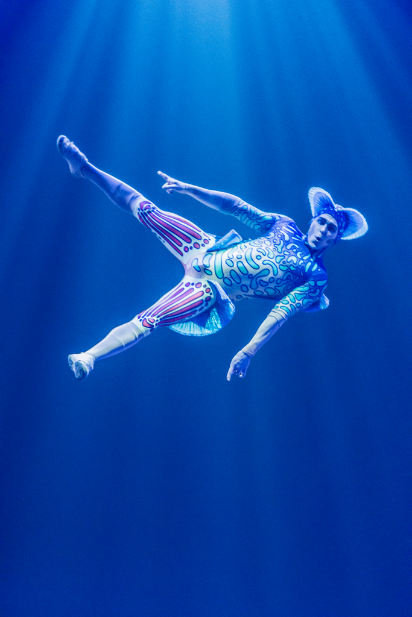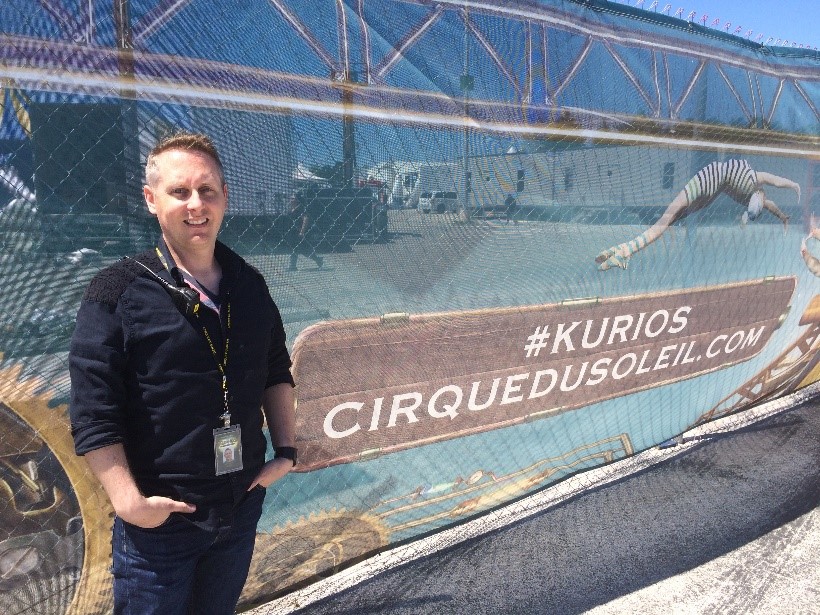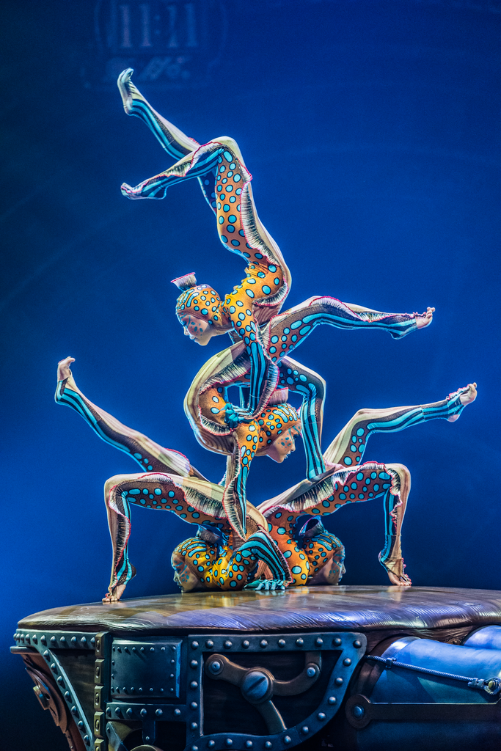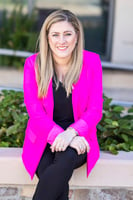Watching the Cirque Du Soleil’s acrobats perform their twisting, juggling, and flying stunts can be an unforgettable experience. We went behind the scenes of KURIOS to find out how Cirque Du Soleil and its’ shows continue to capture the audience. I had an opportunity to sit down with Sasha Alexandr Yudintsev who is an Acro Net Artist with Cirque Du Soleil to talk about his experience with KURIOS.

Sasha Alexandr Yudintsev, Acro Net Artist
What made you want to perform with Cirque Du Soleil?
Well, to have a good job. It is one of the best in the world. I did sport for about 16 or 17 years tumbling and I decided to quit my career and have a job as an acrobat.
Where are you from?
Kazakhstan.
How did you hear about Cirque Du Soleil then?
Because it is world famous, I’ve heard about Russian Circus, Moscow Circus and I felt like it might be a good career.
What is a typical day of practice or training like for the artist in order to achieve flexibility?
We all train for 3-4 hours a day. We have a few ways of training, which is conditioning, trampoline (which is my act) and then I have an act where I juggle also, so you have to spend 5, 6 or even more hours a day of being backstage.
Do you have to eat a certain way?
I don’t, because we move a lot and [burn] calories. But some people have to.
What is your favorite part of the show?
Besides my act, I like the opening act, Chaos.

Photo: Martin Girard / shootstudio.ca Costumes: Philippe Guillotel © 2014 Cirque du Soleil
How does interacting with the different artists play a role in your act?
My act is a group act, there are seven of us. It is one of the main roles. You need to communicate and be able to see. If one of us is off, then all of us are off. So it is important.

Photo: Martin Girard / shootstudio.ca Costumes: Philippe Guillotel © 2014 Cirque du Soleil
Did you have to do a certain exercise in order to trust each other?
Well, because I am still new to this act, I’ve been here for about 8 months, so I am still working on the act with my team.
Have you performed in other cities other than Houston? What is your favorite city so far?
I’ve been in 14 different cities. I actually have two favorite cities: New York and Miami. I don’t like to drive, so I like cities where I can use the subway.

Jeff Lovari, Publicist
I also enjoyed sitting down with Jeff Lovari, Publicist of Cirque Du Soleil to get his thoughts on KURIOS.
The mission of Cirque du Soleil is to invoke the imagination, provoke the senses and evoke the emotions of people around the world. Why is imagination so important?
I think imagination is important because it allows you to grow as a person and become more in touch with yr other humans. I think one of the reasons Cirque Du Soleil has been so successful is because it gives guests the opportunity to see something that either they have never seen before, in most cases, or also in other cases, never even imagined could be possible. And as a company, thankfully we have this talent for finding talent. So not only people who do the physical act of performing on stage, but also the people who dream up these scenarios and these choreographies and these costumes, and music.

Photo: Martin Girard / shootstudio.ca Costumes: Philippe Guillotel © 2014 Cirque du Soleil
So all of these things come together in this way that not only allows the creative team, who puts the shows, to collaborate and continue to push themselves and each other to be more and more creative and use their imagination, but also gives the performers the opportunity to take these roles that they are now inhabiting and also make it their own, add their own twist and skills to it. It is one of the things that as our shows tend to last many years, there is change in the performers.
Even though the character or act may be the same from the original show, it changes because there is a new person doing it. They bring their ability and imagination, creativity, and passion to it. I think that is why our shows are able to perform for 15, 20, 25 years is because it constantly feels fresh for the audience because it is constantly changing. For example, for Sasha’s act, for the seven people in it, maybe six of them have been here for 3 years but Sasha has only been here for 8 months. So his energy impacts the energy of the other people who may have been doing it longer and now they may be looking at it in a fresh way and say what are some new things that we can try and that gives the audience a new experience.
This show is Cirque du Soleil’s 35th production since 1984. In what ways has the show been revamped to continue to reach the audience?
For this show in particular, one of the things that the creative team decided to do was scale back a little bit on all of the technical aspects of some of our more recent shows. One of the things that Cirque Du Soleil is incredibly good at is being really innovative in performance technology whether it is the equipment that we are using, lighting projections or sounds. But for this particular show, let’s make more of the focus on the human performance for this one. So even though it seems like it’s going back to our roots, it then makes a fresh experience for guests who’ve been to the last couple of shows.
So for every creative team or new production, they find what their inspiration is for the show and it was really the human performance. One of the things they did, in terms of creating the stage itself was they made it lower than any of our Big Top shows in the past. And primarily they were able to do that because we did not have any trap doors or people that had to go under the stage. It allows the performers to be closer to the audience. You can look people in the eyes and see their faces. So that was a conscious decision to make the performers have that more intimate connection with the audience. For every show it is different, I would say for this show, the overwhelming inspiration was this high energy, really super fun, jazz influenced music. It is really about the energy.

Photo: Martin Girard / shootstudio.ca Costumes: Philippe Guillotel © 2014 Cirque du Soleil
One of the things we haven’t done before is set the show in a time period that actually existed in history. So the industrial revolution, late 1800s early 1900s was a real time with real people and real stuff. Usually all of our shows are set in a fantasy world or it could be a hundred years ago or two thousand years from now. So using that as a jumping off point to say we are taking this time period where people are inventing all of these amazing things- light bulb, airplanes, and steam power, radios, phonographs, and using that as the jumping off point to say what if those things came to life instead of the inventor inventing these things and bringing them to reality in our world, they pull inventor into their world and take him on a journey instead. So using that as the inspiration you can go almost anywhere which is freeing for people who are creating a show. And it allows them to put the most interesting, energetic, unique things on stage.
How do you go about recruiting your talent and getting the best of the best?
We have a huge casting department and talent scouts. We find people in a number of ways: we do open auditions sometimes in places all over the world so we’ll do a dance audition, circus skills, musicians things like that. We will send talent scouts out to different theatre productions, competitions, high level international gymnastics. With technology being the way that it is, the casting department has their own talent website where people can submit videos of themselves of what they can do.

Photo: Martin Girard / shootstudio.ca Costumes: Philippe Guillotel © 2014 Cirque du Soleil
They take those on an on-going basis. Anytime, anywhere, somebody can submit their resume and video and their guidelines of what they are looking for in terms of ways to present especially if you are far away. And from there, they may call you in for an audition of if you are performing in a show, they may send someone to go see your show. We also have this general formation, where they identify a group of talented potential artists and bring them to the headquarters in Montreal for a period of a few weeks to see what kind skills and strengths they have and create an artist profile for them. So if a position becomes available, they will look for someone with those skills.
Are there any children involved?
There are not for this show, but we do have children at our show in Orlando at Disney World. We have four really incredible Chinese acrobats between the ages of 6 and 11. We also have some child actors in the Beatles Show in Las Vegas.
How may total people does it take to put on a Cirque Du Soleil performance- onstage and behind the scenes?
For this show, there are 125 permanent staff and that includes 46 artists and then all of the technicians, site team, and other employees. And then in every city, we hire about 100 people for the run of the show to work front of house so they can be ushers, work in concessions or wardrobe department. And then we hire people to work to work during the show backstage so by dressing the artists for quick changes. We also hire local people to work in our kitchen, we cook for our performers and staff, and people to help set up and take down the tent.
What is a neat fact that people may not know about this show?
Our contortionists have to stretch about an hour before they do their performance. For some people, it is specific for what they do, so it can be lifting weights or doing cardio. All of the artists do their own makeup, so the time that it takes for them to do that, really helps them get into character and start to focus on the performance. When people enter the tent, they will see a whole line of flags from different countries and that represents the countries of the artists and the staff. I think we are up to 22 different countries.

Photo: Martin Girard / shootstudio.ca Costumes: Philippe Guillotel © 2014 Cirque du Soleil
For this current show, is there a single thread that runs through the whole production to tie each scene together?
So there is a main character, his name is The Seeker. Basically, he is the scientist who is trying to invent all of these things and then, as you’ll see in the beginning of the show, he literally flips the switch in hopes that his creations will do what he wants them to do, and they end up coming to life and sort of taking over. So throughout the show, you will see him interacting with the different characters in different ways as he goes on his journey.
What is your favorite character?
Klara is supposed to be a human telegraph, so her costume relates to that and the things that she is able to do to manipulate her costume, she is just super fun to watch whenever she is on stage. Sasha mentioned that chaos is the opening of the show and there is almost all of the cast on stage for that, and I still find myself watching her every time because she is just so interesting to me.

Photo: Martin Girard / shootstudio.ca Costumes: Philippe Guillotel © 2014 Cirque du Soleil
I’ve seen the characters interacting with the audience before, can we expect that again with this show?
There is something that we call preshow animation, and that is typical for all of our shows at Cirque du Soleil. About 10 to 15 minutes before, you’ll start to see things happening on stage and then some of the artists will come out into the audience.
KURIOS will be in Houston at the Sam Houston Race Park April 6, 2017 - May 21, 2017.


